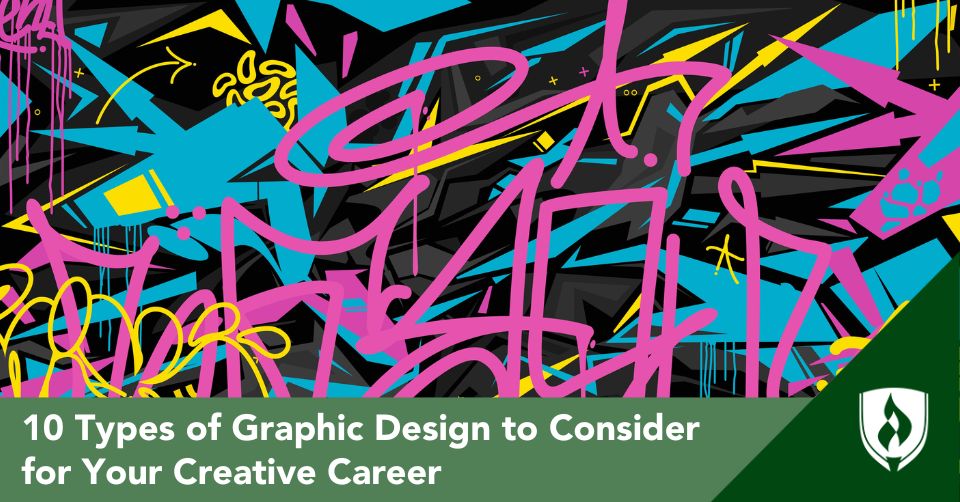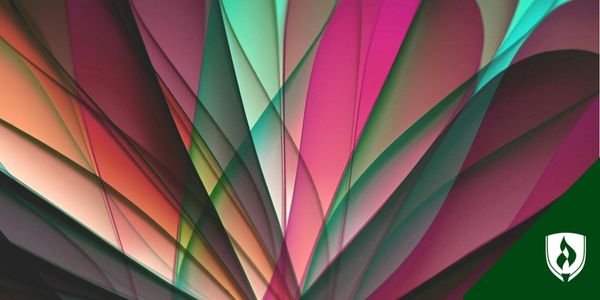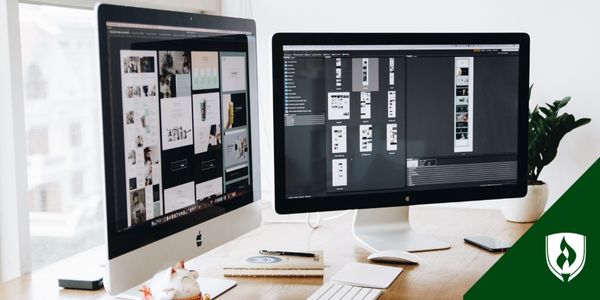
You have an obvious knack for design. From the way you put together outfits to the way you decorate your home, you always seem to know just how to combine different visual elements in a way that makes a statement.
Creating your own aesthetic is fun. But, turning your passion into a career? That’s what you really want! There’s power in graphic design. When wielded with care, design is a tool, capable of influencing our feelings, behaviors and responses. “Design mediates between people and decisions; whether subtle or overt, design promotes a point of view,” writes the American Institute of Graphic Arts (AIGA®). Through design, we can connect and spread important messages—messages words alone can’t embody.
You’ve heard about graphic designers, and you understand they use their creative skills to make a living. But how does that work each day? What are the different types of graphic design? Here's an overview.
10 types of graphic design to consider for your creative career
The graphic design field is broad and dynamic—there are so many types of graphic designers! In this field, you might find yourself working across different media and industries. You’ll use your creative skills to solve a wide range of business problems.
Whether you support public service announcements, create new, lovable cartoon characters or develop consumer products to solve a problem, design skills find a home in almost every industry.
So, take a peek at all the different types of graphic design and see which ones you gravitate towards.
1. Product design
Product designers conduct market research to make sure their product will appeal to the target audience and won’t violate competitors’ copyrights. Then, they’ll create early illustrations and prototypes of their designs before they’re sent into production.
From kitchen gadgets to closet organizers to furniture, virtually every product we buy is the creation of a product designer—or, often times, a team of designers. These professionals may be called product designers or industrial designers.1
Product design combines problem-solving skills with engineering to produce a new item that fits a particular need.
For example, look no further than your vegetable peeler. It was designed to help make prepping ingredients quick and convenient. And, depending on the model, ease of use and ergonomics may have influenced the final product’s look and feel, too.2
Industrial design is all about solving a problem for the end user. We see endless examples of it in our lives every day.
Of course, the types of products these designers create varies. Ultimately, as a product designer, the work you do will depend heavily on where you’re employed. You might work in automobile manufacturing, home appliances or even children’s toys—the sky’s the limit! 2
- Type of product: Items, product packaging, marketing designs, product illustrations and prototypes.
- Skills needed: Market research, prototyping, 3D modeling, Adobe Creative Suite®.
2. Branding and visual identity design
Branding is a type of corporate design that focuses on the visual identity (AKA the brand identity) of a company or product. A company’s visual identity plays a major role in defining the brand’s personality.
Brand personality and brand identity are represented through a myriad of factors, some of which include logo design, brand mascots and even the typeface used on product packaging and other marketing materials.3
Brand identity designers must be in tune with the marketing message a company wants to send. In addition, graphic designers working in this space have to be cognizant of the target audiences their clients wish to reach.
Every aspect of branding design must align with these goals, as well as fit into the larger aesthetic of the company or organization. Consumers’ perception of a company is often driven by their branding, so graphic designers in this specialty put all their skills to work developing a visual brand that will connect with the target audience and project an appropriate message about the company.
- Types of product: Logos, website branding, company letterhead, business cards, signage, company brochures.
- Skills needed: Adobe Creative Suite, market research, communication skills, teamwork.
3. Mobile app design
What do social media, shopping, email and banking mobile apps all have in common? As it turns out, graphic designers have a significant impact on the success or failure of each.
“If your app doesn’t have a good user experience, it goes to the app graveyard,” states the Mobile User Experience Guidelines.4
Graphic designers who specialize in mobile app design spend their days figuring out how to best construct apps’ user interfaces. The user interface (UI) design is fundamental for onboarding—and retaining—new app users. That’s right; popular mobile apps have designers (among others) to thank for their success!
Look at it this way: When was the last time you downloaded an app that came with a user manual? Probably never. In today’s fast-paced, mobile-first world, consumers expect to be able to understand how to navigate an app within moments of installing it.5
Graphic designers who work on mobile apps must balance aesthetic appeal with technical functionality. These design pros need a strong sense of user experience (UX) design to make sure the apps they work on are intuitive, engaging and, most importantly, helpful.
- Types of product: Mobile apps, mainly for Android® and iOS®
- Skills needed: UI design, Adobe Creative Suite, communication skills, teamwork.
4. Website design
Today, there’s a graphic designer behind nearly every website you visit. We may take this for granted, but we all depend on good web design to find information and products online. Web designers incorporate UX design principles in conjunction with site owners’ branding and visual identity preferences.
Website designers, AKA “web designers,” decide how a website’s user interface should look and function. Like mobile app designers, these professionals are UI designers. They not only make websites visually appealing, but also determine the content’s layout.
Good web design accommodates user intent as well as the functions and goals of the website owner.
Take Google, for instance. It’s been more than two decades since the search engine first launched (and, arguably, changed the way the entire world uses the internet).
Yet, aside from the famous Google Doodles and 2015’s logo redesign, the user interface of Google’s homepage remains virtually unchanged. Even after all this time, the search bar remains front and center, where it’s been for nearly 30 years, now.
But, it’s no mystery why the Google homepage of today still resembles that of the late ‘90s: it works.
Most of us visit Google.com with one goal, and one goal only: to run a search. And that’s exactly what the homepage design encourages.
Of course, not every website is as cut-and-dry as Google. While practically everyone uses search engines for a single function (research), we may all differ in the actions we take on other websites.
For example, you might visit an online clothier’s site to browse new arrivals—or you might instead be there to check your order status. Alternatively, you might just visit to check out their fashion blog for styling tips.
See how much user intent can vary for just a single website? This is why UI designers and web designers are so important.
Web designers use their graphic design skills to create online spaces that are aesthetically pleasing, easy to navigate, compatible with SEO best practices and aligned with their clients’ branding.
- Types of product: Websites and apps.
- Skills needed: Branding, UX design, wireframing, SEO, basic coding, problem solving.
5. Print design
We may be living in the digital age, but the print medium is still alive and well!
A graphic designer specializing in print will create designs suited for physical media. This might include anything and everything from movie posters to pamphlets, brochures, catalogs, stationary and even T-shirt designs. Essentially, print production can involve any material item.
- Types of product: Brochures, flyers, billboards, stickers, stationery sets, T-shirts, mugs and other products.
- Skills needed: Layout design, print design, color theory, Adobe Creative Suite.
6. Publication design
When we think about our favorite novels and memoirs, we usually think of the authors who wrote them—but graphic designers contribute greatly to published works’ success. If you’re a self-proclaimed bookworm, this type of graphic designing could be right up your alley!
Publication design can be thought of as a specialty area within print design. Graphic designers who work in the publishing industry typically help prepare books and magazines for print production.
Publication designers may be responsible for creating eye-catching covers for books, magazines and tabloids, for example. These professionals develop designs with the goal of appealing to market audiences, while using visual cues to communicate key elements of the content inside.
If you work in publication design, you might have the chance to create a new visual identity for an updated edition of your favorite bestseller.
Or you might lend your talents to a new author launching a debut novel.
If you work in the magazine industry, you may even design page layouts to help present information that’s both visually attractive and easy to read.
Publication designers work closely with writers and editors to achieve just the right look.
- Types of product: Book and magazine covers, ebook layout and design, magazine spreads, graphs or other images in nonfiction books.
- Skills needed: Adobe Photoshop, Adobe InDesign®, market research, attention to detail.
7. Environmental graphic design
Environmental graphic designers combine basic design principles with elements of architecture and landscape design. They create signs, maps and other visual elements that people use to navigate the world around them.
“It encompasses the broader notion of all communication in the build environment,” writes the Society for Experiential Graphic Design (SEGD). This includes visuals like digital text that appears on the exterior of buildings, museum exhibit layouts, and the development of “smart cities.”
- Types of product: Signage, exterior building displays, wayfinding systems, retail store design, museum exhibits, and exterior design elements such as fountains and sculptures.
- Skills needed: Creativity, communication skills, urban design, Adobe Creative Suite.
8. Animation design
Animation and motion graphics designers use specialized software to create everything from cartoons to animated social media graphics. Motion graphic design can provide entertainment via TV shows or video games, draw attention to a corporate social media account or help people learn through animated informational videos.
Animation designers work as part of a larger team to take their creative ideas from rough sketches to fully animated creations.
- Types of product: Video games, cartoons and animations for television or movies, brand animation for social media channels, motion graphics for online videos.
- Skills needed: Storyboarding, CAD software, video editing software, problem solving, teamwork.
9. Packaging design
We often really do judge a thing by its cover.
Maybe it’s a snack. Or a drink. Or a luxurious-looking shampoo. In any case, packaging designers inspire impulse purchases everywhere.
These are the graphic designers who use their artistic talents to give brands a competitive edge in the retail environment. Packaging design encompasses everything from the box around a blow dryer to the bottle of sunscreen explaining how often to reapply for maximum UV protection.
Good packaging design is as helpful for us, the consumers, as it is for brands and retailers looking to capitalize on their ability to capture our attention. That’s because packaging designers communicate the benefits we can expect to enjoy if we decide to purchase the snacks, drinks, shampoos and etc. for which they design.
In fact, depending on the product(s) in question, these graphic designers also include important instructions for use. Designers figure out how to incorporate important text—along with relevant branding, iconography and other images—in an intuitive packaging design.
Consider your shampoo, for instance: does it come in a tube, an oversized jug or a bottle with a pump? Product packaging designers probably worked closely with packaging engineers (whose duties can overlap with those of designers) to develop the container now sitting in your bathroom.
- Types of product: product labels, boxes, bottles, cans, blister cards, bags, sleeves, wrappers and other product containers.
- Skills needed: CAD software, Adobe Creative Suite, communication, problem-solving.
10. Marketing and advertising design
Graphic designers frequently lend their expertise to marketing and advertising initiatives. These types of graphic design projects may include everything from promotional products (like pens and water bottles emblazoned with a brand’s logo design) to social media ads.
In fact, you probably see examples of marketing and advertising design all around you, every day. Ever caught yourself distracted by an ad on social media? That’s exactly what good graphic design is capable of.
- Types of product: traditional and digital marketing campaigns (print ads, banner ads, social media ads, etc.), email marketing templates, promotional products, billboards, print banners, signage
- Skills needed: Adobe Creative Suite, communication, problem-solving
Honorable mention: illustration
To the untrained eye, a graphic design and an illustration might seem like two sides of the same coin. Sure, there are similarities between the two. And graphic designers tend to share many of the same skills and strengths a graphic illustrator has.
Yet, there’s one key difference: creating illustrations requires graphic artists who are capable not only of ideating original imagery, but also drawing it.
At its core, graphic design is about arranging separate graphic elements into a visual hierarchy to create a unified image. These graphic elements may come from a variety of sources, but, generally, graphic designers aren’t required to create them.
For instance, a graphic designer may create a banner ad by overlaying a company’s logo onto a purchased stock photo and incorporating text using a typeface from Adobe Illustrator.
A graphic illustrator, on the other hand, creates images “from scratch.” These custom illustrations are often hand-drawn, either with physical media (like paper and ink) or using modern technology (like a tablet and stylus).
Whereas graphic designers may have training or education in fine art, illustrators must be capable of drawing, sketching and working with their hands.
- Types of product: book illustrations, posters, greeting cards, T-shirts, website and social media graphics
- Skills needed: sketching, drawing, painting, shading, blending, Adobe Creative Suite
Why are graphic design skills important?
The value of graphic design goes much deeper than simply adding aesthetic appeal to a project. A company’s visual representation can have a wide-reaching impact on its customers—and on its success as a business.
Graphic design helps define a user’s visual experience of physical products, digital properties and the companies behind them.
What is the difference between graphic design degrees?
There are so many different programs out there. But one main difference in graphic design degrees is between an associate’s and a bachelor’s degree.
An associate’s degree in graphic design can be completed in as few as 18 months. This degree can prepare you for a role as a digital designer, production artist, graphic specialist, video editor, print designer, motion graphic designer and more.
It can also prepare you to take an exam for industry certifications to help you stand out from other applicants. To see all those details, check out Rasmussen’s Associate’s Degree in Graphic Design page.
A bachelor’s degree in graphic design will take you deeper into the tools and foundational knowledge of graphic design.
Depending on if you have any transfer credits or other college courses to build on, these programs can take anywhere from 18 months to four years to complete.
You can gain the skills to advance a career in fields like motion graphics, web design, video editing, graphic design, user interface design and a long list of others.
Check out Rasmussen’s Bachelor’s Degree in Graphic Design page to see what this well-rounded degree program will prepare you for, get tuition details and more.
Which type of graphic design is right for you?
You can see from these types of graphic design that there are plenty of options available to aspiring designers. No matter which aspect of this creative career has captured your interest, you’re probably wondering how to take the next step.
So, should you pursue a degree in Graphic Design? Find out in our article, “Is a Graphic Design Degree Worth It or Worthless?”
AIGA® is a registered trademark of American Institute of Graphic Arts
Adobe Creative Suite® is a registered trademark of ADOBE INC.
Android® is a registered trademark of GOOGLE LLC
iOS® is a registered trademark of APPLE INC.
Adobe In Design® is a registered trademark of ADOBE INC.
Adobe Illustrator® is a registered trademark of ADOBE INC.
1Industrial Designers [accessed February 2024] https://www.bls.gov/ooh/arts-and-design/industrial-designers.htm
2Mark Wilson, The untold story of the vegetable peeler that changed the world, (Accessed February 2024), A history of the oxo good grips peeler (fastcompany.com)
3Ivan De Luce, The 34 Greatest (and most recognizable) brand mascots of all time, (Accessed February 2024), Greatest Brand Mascots to Make It to the Madison Avenue Walk of Fame (businessinsider.com)
4Mobile User Experience Guidelines Six user experience guidelines for creating a mobile product, (Accessed February 2024), Mobile User Experience Guidelines – Digital.gov
5The Essential Guide to In-App Onboarding in 2023, (Accessed February 2024), The Essential Guide to In-App Onboarding in 2023 (userpilot.com)




